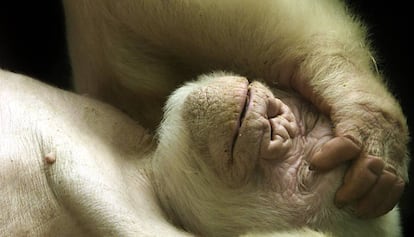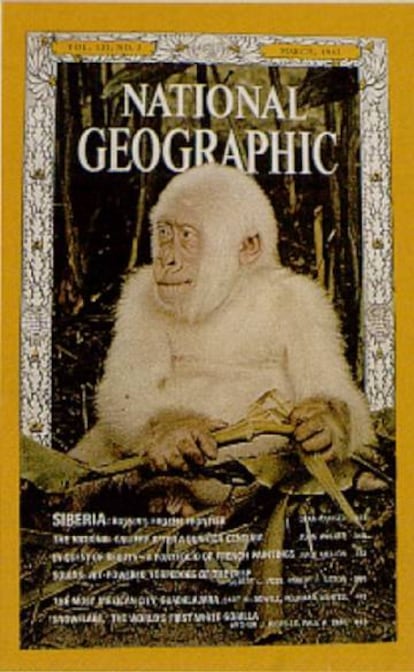Barcelona yet to honor ‘Snowflake,’ 13 years after his death
The world-famous albino gorilla was once one of Barcelona’s most famous symbols

Whether it’s Gaudí’s Sagrada Familia, or the popular La Rambla street, the covers of Barcelona travel guides proudly show off the main attractions of the city. But there is one symbol from the Catalan capital that has long since disappeared: Snowflake, the only albino primate known in the world, and which used to be the main attraction at Barcelona zoo.

The mammal died 13 years ago, at the age of almost 40. At that time the then-mayor of Barcelona, Joan Clos, promised to name a street after him, as well as commissioning a hyper-realistic sculpture of the gorilla. However, neither plan came to fruition.
Years later, Mayor Xavier Trias suggested building a path in Ciutadella park, where the zoo is located, and naming it after Jordi Sabater Pi (1922-2009), the primatologist who bought Snowflake from a hunter and brought him to Barcelona. Trias wanted to pay indirect tribute to Floquet de Neu, as the gorilla was known in Catalan. But that project didn’t catch on either.
Barcelona City Hall claims that administrative reasons preclude it from naming a street after Snowflake. What’s more, the team in charge of naming Barcelona’s streets has said that it has not received an application to put the albino gorilla’s name on an official plaque.

The story of Snowflake dates back to October 1, 1966, when a group of hunters from Equatorial Guinea killed a family of gorillas. Behind one of the females an albino baby appeared. It was aged between two and three years old. One of those hunters sold this unusual animal to Sabater Pi. A month later, the gorilla arrived in Barcelona and the then-mayor, José María de Porcioles, was there waiting for his arrival. Twelve months on, and Snowflake appeared on the cover of National Geographic magazine, becoming in the process one of the most famous symbols of Barcelona.
In September 2003, second deputy mayor and president of Barcelona zoo, Jordi Portabella, announced that “Little Snowflake” was going to pass away. “It is not a case of years or months, it will be weeks,” he said. Skin cancer ended his life.
Sabater Pi argued that the unique gorilla should be stuffed, in order to preserve him. He thought that he would continue attracting visitors even after his death. But in the end, the animal was incinerated in order to preserve “his dignity.”
Teresa Abelló, who has been working with the primates in Barcelona Zoo since 1985, says: “I was concerned about all the gorillas, but little Snowflake was so special, we only had eyes for him.” The biologist adds that the gorilla was “a model grandparent, he played and took care of his grandchildren and was a charming animal.” She remembers how he moved and how they treated a wound he had in his armpit. On October 23, 2003 his agony was irreversible, so the following day a lethal injection ended with its life painlessly.
Snowflake’s remains were donated to universities, high schools and research centers
Snowflake’s remains were donated to universities, high schools and research centers. The Animal Tissue Bank of Catalonia kept fluid, tissue and brain samples. The Dexeus University Insitute was given the gorilla’s reproductive system, including his sperm. The Pompeu Fabra University holds tissue and DNA, while Barcelona University has skin samples and the Natural History Museum of Barcelona has part of his skeleton and some skin. A mold of the gorilla’s head, hands, feet and chest was taken in order to design a hyper-realistic sculpture, but it is yet to be created. But none of these remains can be accessed, given that these institutions all signed confidentiality agreements.
The remains that no one else wanted were burned and inserted into a biodegradable vase, mixed with the seeds of a typical African tree. The vase was buried in the zoo. According to an urban legend a lawnmower cut the stem that grew from the buried seeds. What is known for sure, however, is that six years after Snowflake’s death the zoo was refurbished, and where the tree should have sprouted from the gorilla’s remains, there is now a garden where red kangaroos jump.
English version by Albert Cadanet and Marc Corominas.
elpais.cat in English
From November onward, the Catalan edition of EL PAÍS, Elpais.cat, will include a selection of news stories in English.
The texts will be prepared by journalism students at the Pomepeu Fabra University (UPF), who will be adapting content from Catalan current affairs every week, adding extra information and explanation to these stories so that they can be understood in a global context.
Tu suscripción se está usando en otro dispositivo
¿Quieres añadir otro usuario a tu suscripción?
Si continúas leyendo en este dispositivo, no se podrá leer en el otro.
FlechaTu suscripción se está usando en otro dispositivo y solo puedes acceder a EL PAÍS desde un dispositivo a la vez.
Si quieres compartir tu cuenta, cambia tu suscripción a la modalidad Premium, así podrás añadir otro usuario. Cada uno accederá con su propia cuenta de email, lo que os permitirá personalizar vuestra experiencia en EL PAÍS.
¿Tienes una suscripción de empresa? Accede aquí para contratar más cuentas.
En el caso de no saber quién está usando tu cuenta, te recomendamos cambiar tu contraseña aquí.
Si decides continuar compartiendo tu cuenta, este mensaje se mostrará en tu dispositivo y en el de la otra persona que está usando tu cuenta de forma indefinida, afectando a tu experiencia de lectura. Puedes consultar aquí los términos y condiciones de la suscripción digital.
Últimas noticias
El Louvre, en su punto más bajo: ¿qué le pasa al museo más famoso del mundo?
Kate Winslet nos habla de su debut como directora (y de lo difícil que sigue siendo ser mujer en el cine)
La Administración de Trump publica (a medias) los papeles de Epstein: ¿cuáles son las principales novedades?
Cómo llegaron los líderes europeos al acuerdo para financiar a Ucrania
Lo más visto
- Uno de los promotores de la señal V-16 de tráfico: “Es duro oír el testimonio de víctimas que han sufrido amputaciones al poner los triángulos”
- Más de 40 congresistas demócratas piden por carta a Trump que cese en sus “intentos de socavar la democracia en Brasil”
- Cae una organización que enviaba camiones cargados de cocaína desde Marbella hasta varios países europeos
- La policía registra varios domicilios y las oficinas de la ministra francesa Rachida Dati por otro presunto caso de corrupción
- Manuel Castells, sociólogo: “El mundo está en un proceso de autodestrucción”




























































